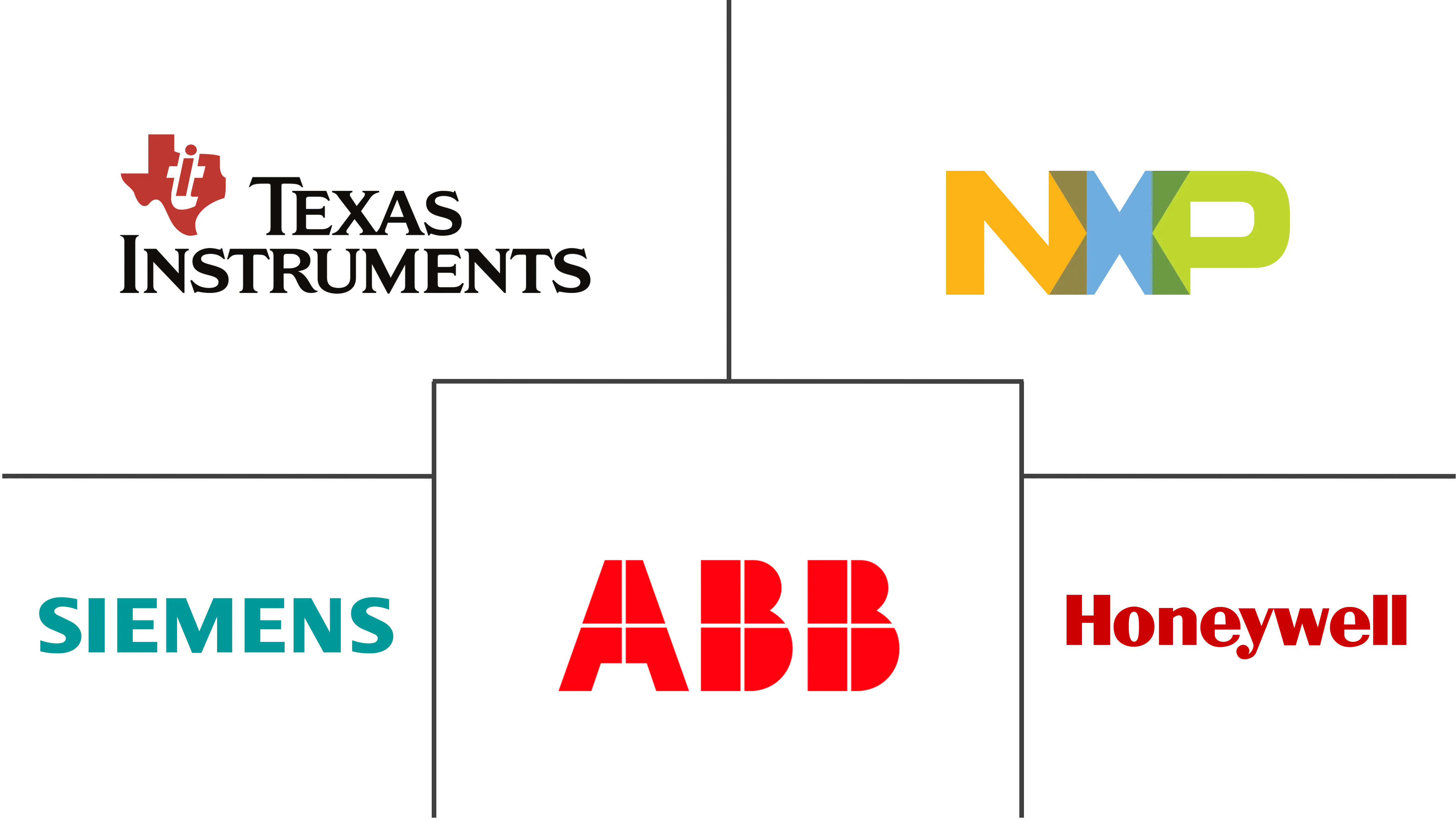Americas Sensor Market Size and Share
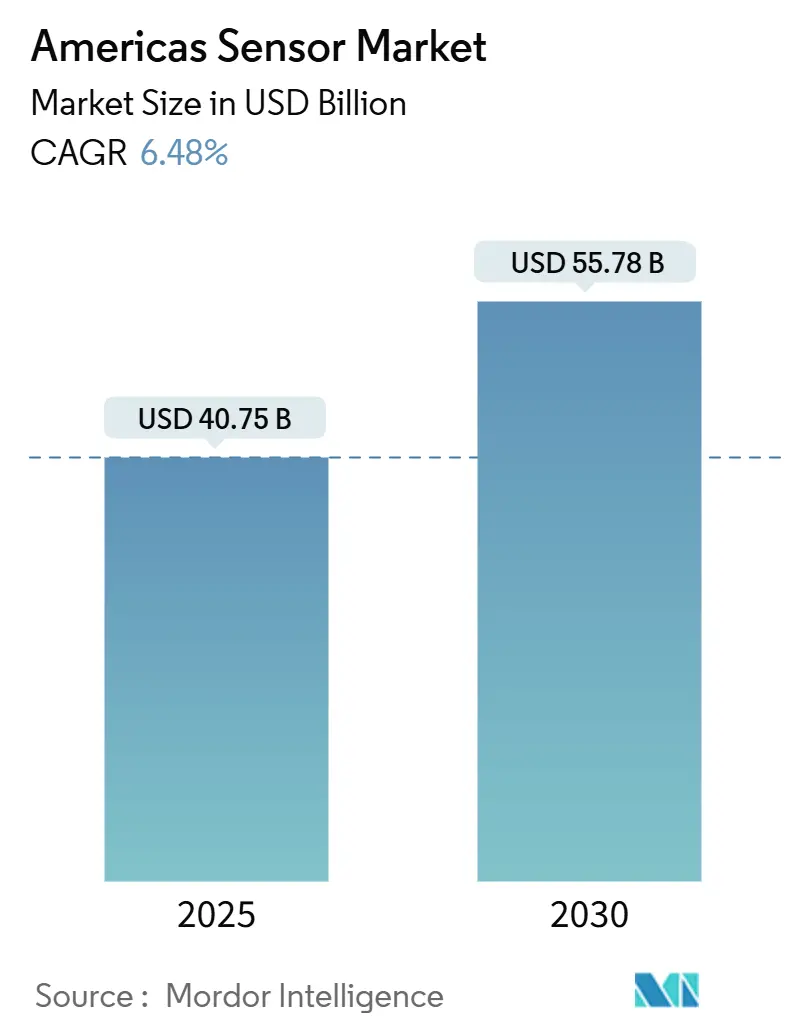
Americas Sensor Market Analysis by Mordor Intelligence
The Americas sensor market size stands at USD 40.75 billion in 2025 and is forecast to reach USD 55.78 billion by 2030, reflecting a 6.48% CAGR. Quantum‐enabled navigation systems, low-power edge-AI processing, and MEMS miniaturization together create the strongest pull on demand, while heavy public-sector funding for smart infrastructure accelerates large-scale deployments. Investments in autonomous vehicles, precision agriculture, and renewable-energy monitoring are intensifying competition around LiDAR, environmental, and vibration sensing technologies. Supply-chain reshoring for gallium-nitride and silicon-carbide substrates gains urgency as geopolitical frictions persist. Strategic M&A - most notably STMicroelectronics’ planned USD 950 million purchase of NXP’s sensor unit - signals a shift toward vertically integrated platforms offering secure, AI-ready sensor fusion capabilities.
Key Report Takeaways
- By parameter measured, temperature sensors led with 19.8% revenue share in 2024, while environmental sensors are advancing at an 8.2% CAGR through 2030.
- By mode of operation, capacitive sensors accounted for 18.1% of the Americas sensor market share in 2024, whereas LiDAR is forecast to expand at an 8.3% CAGR to 2030.
- By sensor technology, MEMS captured 59.7% of the Americas sensor market size in 2024 and is growing at a 7.9% CAGR.
- By end-user industry, consumer electronics held 23.4% revenue share in 2024; automotive is the fastest-growing segment at a 7.7% CAGR through 2030.
- By geography, the United States commanded 39.6% of 2024 regional revenue, while Mexico posts the highest projected CAGR at 7.3% to 2030.
Americas Sensor Market Trends and Insights
Drivers Impact Analysis
| Driver | (~) % Impact on CAGR Forecast | Geographic Relevance | Impact Timeline |
|---|---|---|---|
| Rapid proliferation of consumer IoT devices | +1.2% | North American urban centers | Medium term (2-4 years) |
| Rising automation investments in manufacturing | +1.0% | United States, Mexico, Brazil | Medium term (2-4 years) |
| Government incentives for smart-infrastructure | +0.8% | United States, Canada | Short term (≤2 years) |
| Expansion of electric and autonomous vehicles | +1.1% | North America, Mexico | Long term (≥4 years) |
| Emergence of low-power edge AI | +0.7% | North American tech hubs | Long term (≥4 years) |
| Increasing adoption of printable sensors | +0.5% | United States, Brazil | Medium term (2-4 years) |
| Source: Mordor Intelligence | |||
Rapid Proliferation of Consumer IoT Devices
Smart-home penetration now reaches mass-market levels in major U.S. and Canadian cities, creating sustained demand for low-power wireless sensors that can operate for years on a coin cell. The U.S. Department of Transportation’s SMART Grants are catalyzing citywide traffic and air-quality sensor rollouts, locking in procurement budgets and standardizing connectivity protocols.[1]U.S. Department of Transportation, “SMART Grants Program,” transportation.gov Edge-AI chipsets embedded inside these devices eliminate cloud latency and protect data privacy - critical for jurisdictions implementing strict digital sovereignty rules. The resulting volume lift underpins economies of scale for MEMS suppliers, with spillover demand in Latin American metros upgrading public-transport networks.
Rising Automation Investments in North and South American Manufacturing
OEMs across the United States and Mexico retool production lines with vibration, acoustic, and thermal sensors that feed predictive-maintenance algorithms, slashing unplanned downtime. Petrobras-supplied Brazilian plants deploy sensor-based energy dashboards to curb utility costs and satisfy ESG reporting mandates. TotalEnergies’ refinery pilot with wireless vibration sensors demonstrated a full quarter without unscheduled shutdowns, validating ROI for widescale rollouts.[2]TWTG, “TotalEnergies Eliminates Downtime Using Vibration Sensors,” twtg.io These wins accelerate cross-border knowledge transfer, hardwiring sensor adoption into automotive, metals, and food-processing corridors from Detroit to Monterrey and São Paulo.
Government Incentives for Smart-Infrastructure Retrofits
Washington’s Infrastructure Investment and Jobs Act unlocks multibillion-dollar budgets for smart-grid equipment, mandating secure environmental, occupancy, and asset-health sensors across federal facilities. Parallel programs in Ontario and British Columbia press public-sector agencies to install real-time air-quality and lighting-efficiency sensors. Vendors with pre-certified cybersecurity and interoperability features enjoy rapid procurement cycles and reduced qualification costs, widening the addressable slice of the Americas sensor market.
Expansion of Electric and Autonomous Vehicles Requiring Multi-Sensor Suites
Boeing’s four-hour quantum-navigation flight teased GPS-free inertial accuracy, energizing funding for next-generation automotive IMUs.[3]Boeing Co., “Beyond GPS: Quantum Navigation Flight Test,” boeing.com Electric-vehicle battery packs integrate dense arrays of pressure and temperature sensors to safeguard against thermal runaway, while Level-4 autonomy stacks demand high-resolution LiDAR and radar fusion. Supply agreements between Tier-1 automotive suppliers and MEMS foundries lock in multi-year volumes, pushing sensor ASPs downward yet broadening total addressable shipments.
Restraints Impact Analysis
| Restraint | (~) % Impact on CAGR Forecast | Geographic Relevance | Impact Timeline |
|---|---|---|---|
| Stringent regulatory certification | -0.6% | North America | Short term (≤2 years) |
| High capital expenditure for MEMS fabs | -0.4% | Global manufacturing centers | Long term (≥4 years) |
| Supply-chain concentration in exotic materials | -0.5% | North America | Medium term (2-4 years) |
| Cyber-security liabilities | -0.3% | Global defense and healthcare | Medium term (2-4 years) |
| Source: Mordor Intelligence | |||
Stringent Regulatory Certification for Safety-Critical Sensors
Automotive functional-safety regulations extend validation cycles by up to 18 months, disfavoring venture-backed startups that lack dedicated compliance teams. FDA mandates for clinical-grade wearables impose costly biocompatibility and post-market surveillance audits, reinforcing incumbent advantage as the Americas sensor industry consolidates.
Supply-Chain Concentration in Exotic Materials (GaN, SiC)
Limited gallium-nitride and silicon-carbide wafer output from Asia tightens lead times and spikes prices for high-performance power and radar sensors. STMicroelectronics’ plan to start 200 mm SiC production in Catania by late 2025 exemplifies regional diversification efforts aimed at buffering the Americas sensor market against geopolitical shocks.[4]STMicroelectronics N.V., “ST to Launch 200 mm Silicon Carbide Production in Catania,” investors.st.com
Segment Analysis
By Parameter Measured: Environmental Sensors Drive Sustainability Compliance
Environmental sensors post the fastest 8.2% CAGR as corporates race to meet Scope-1 emissions targets and municipal bodies mandate real-time air-quality data. Temperature devices nonetheless hold the largest 19.8% slice of the Americas sensor market share, thanks to ubiquitous HVAC and consumer-electronics integration. Pressure and level sensors scale within energy pipelines and smart water networks, a trend amplified by drought-mitigation projects across the Western United States. Flow and proximity sensing gain traction in robotics and packaging lines as factories pivot to lights-out operations. Quantum magnetometers and inertial units - piloted by Honeywell for defense contracts - hint at a coming wave of ultra-precise navigation applications.
Second-order adoption effects surface in agriculture, where vibration and chemical sensors diagnose soil compaction and nutrient levels, respectively. Miniaturized MEMS humidity sensors embedded in wearables push health-monitoring use cases, while magnetic sensors underpin renewable-energy turbine position tracking. Collectively, these dynamics keep environmental solutions front and center in procurement roadmaps and increase their proportion of the Americas sensor market.
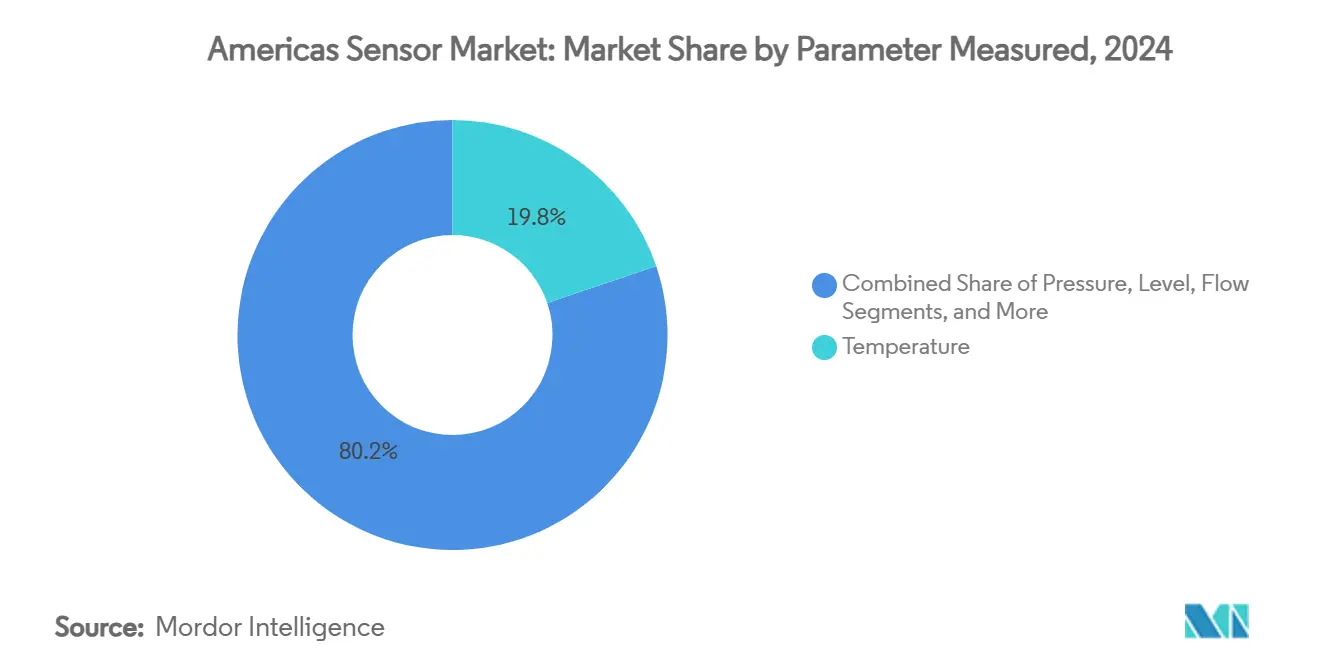
Note: Segment shares of all individual segments available upon report purchase
By Mode of Operation: LiDAR Technology Accelerates Autonomous Systems
LiDAR’s 8.3% CAGR outpaces all other operational classes as automotive OEMs lock in next-generation ADAS platforms. Simultaneously, capacitive devices maintain an 18.1% leading share by unit shipments because of sustained touchscreen, proximity, and fill-level applications across consumer and industrial sectors. Optical and imaging sensors deepen penetration in telemedicine and air-quality analytics, benefitting from edge-AI-enhanced noise suppression. Electrical-resistance and biosensors carve niches in cold-chain logistics and continuous glucose monitoring—segments highly sensitive to accuracy and calibration drift.
Radar modules extend beyond collision-avoidance systems into perimeter security and industrial crane automation, filling performance gaps where optical LOS is compromised. Multi-mode fusion stacks that co-package LiDAR, radar, and imaging units emerge as the reference architecture for autonomous shuttles, further expanding the Americas sensor market size attached to autonomy solutions.
By Sensor Technology: MEMS Dominance Continues Despite Challenges
At a 59.7% revenue share and 7.9% CAGR, MEMS remains the backbone of the Americas sensor market. Batch micro-fabrication lowers unit costs even as die-shrink limits near. AI-optimized ASICs bonded atop MEMS dies deliver on-sensor analytics, slashing latency and cloud egress fees. Yet, the USD 500 million-plus price tag for greenfield 300 mm fabs restricts entry to firms with substantial balance sheets. STMicroelectronics’ restructuring and Agrate/Crolles expansions exemplify the capex intensity required to secure MEMS volume and maintain end-to-end control.
Flexible MEMS prototypes enable stretchable skin patches for hospital wards and sports science labs, hinting at incremental unit growth outside legacy handset cycles. Non-MEMS devices, meanwhile, preserve relevance in extreme-temperature, radiation-hard, and metrology-grade contexts where sub-ppm accuracy trumps die size or cost.
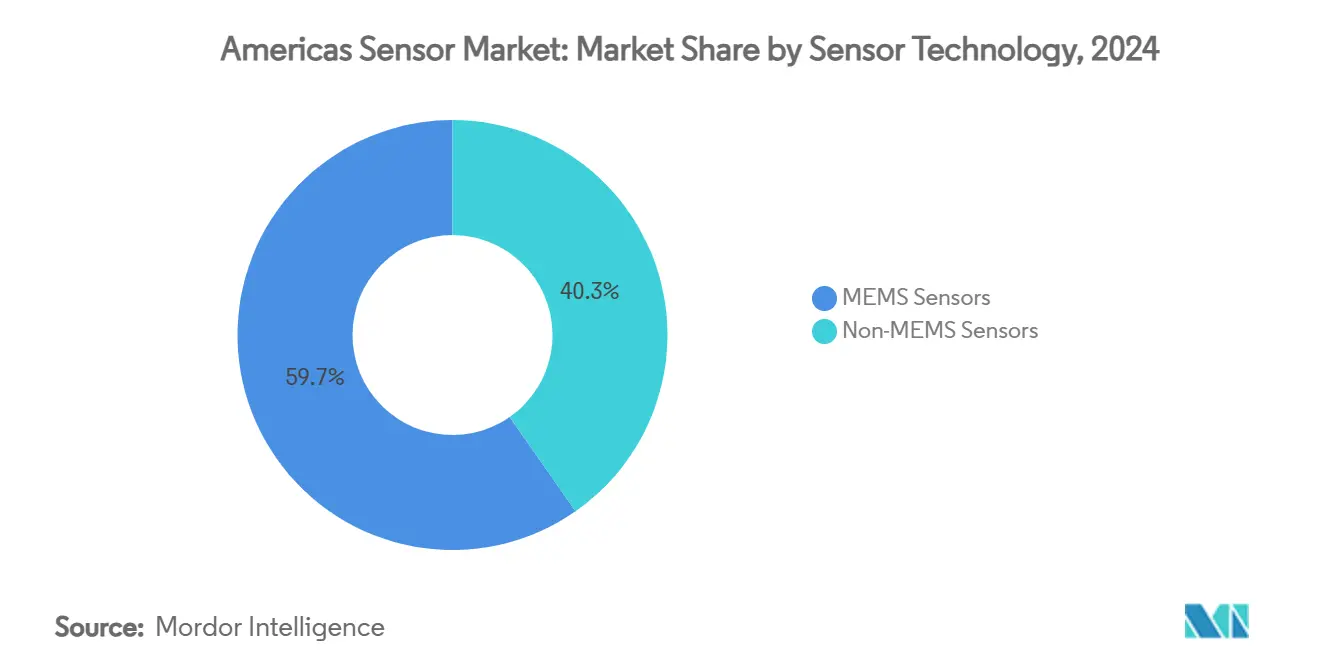
By End-user Industry: Automotive Sector Leads Growth Transformation
Automotive’s 7.7% CAGR stems from electrification curves and progressive ADAS regulation in the United States and Canada. Battery-pack sensors capable of ±1 °C accuracy prevent thermal events while pressure sensors monitor coolant loops. Consumer electronics, still the volume heavyweight at a 23.4% share of America's sensor market size in 2024, broadens into AR/VR headsets and ultra-low-power hearables. Industrial automation adopts vibration, acoustic, and torque sensors to sustain predictive-maintenance ROI, particularly in Mexican and Brazilian plants optimized for export compliance.
Energy and utilities exploit distributed sensor clusters for real-time grid balancing across high-renewables penetration zones. Healthcare sees biosensing patches migrate from clinical trials to reimbursed telehealth programs. Aerospace and defense demand quantum-grade inertial measurement units for GPS-denied navigation, validating sustained high-margin niches for suppliers.
Geography Analysis
The United States, at 39.6% of 2024 revenue, benefits from unparalleled federal R&D funding flows and early-stage venture capital targeting quantum sensors, LiDAR, and edge-AI silicon. National infrastructure modernization funnels large orders for environmental and structural-health sensors into transportation and power grids. Domestic reshoring incentives for critical semiconductors shield supply lines and reinforce the Americas' sensor market leadership position.
Mexico delivers the fastest 7.3% CAGR through 2030. Its integrated automotive hub spanning Monterrey to Guanajuato mandates advanced quality-assurance sensors for EV platforms destined for U.S. and EU export markets. Free-trade compliance accelerates the localization of MEMS packaging and final testing lines, drawing ecosystem partners and lifting the regional Americas sensor market share.
Brazil and Canada round out the next-tier opportunities. Brazil leans on soil-moisture and satellite-linked environmental sensors to optimize soy and sugar-cane yields, while Petrobras upgrades offshore rigs with corrosion-monitoring arrays. Canada prioritizes ruggedized temperature and flow sensors for Arctic energy operations and deploys precision-agriculture IoT systems across Prairie provinces. Argentina, Chile, and the rest of the Americas tap mining and renewable-energy ventures to justify incremental spend on vibration, gas-analysis, and LiDAR mapping solutions.
Competitive Landscape
Moderate fragmentation prevails as no single vendor exceeds a significant revenue share across the Americas sensor market. Texas Instruments, STMicroelectronics, and Honeywell anchor the top tier, combining broad silicon portfolios with domain-specific software. STMicroelectronics’ USD 950 million bid for NXP’s sensor unit underscores a race for automotive and industrial design wins. Parallel partnerships - such as the SICK-Endress+Hauser joint venture - meld optical gas analysis with flow-measurement expertise to service decarbonization projects.
Startups in quantum navigation and printable electronics attract defense and healthcare contracts, leveraging asset-light models to sidestep MEMS fab capex. SandboxAQ’s AQNav solution, already exceeding 200 flight hours, demonstrates how AI-driven quantum IMUs can exit the lab and enter revenue generation. Incumbents counter with secure firmware-over-the-air stacks and vertically integrated supply chains that mitigate GaN and SiC shortages.
Talent scarcity in RF and photonics design intensifies acquisition premiums, with Teledyne’s purchases of Valeport and Micropac augmenting deepwater and high-reliability product lines. Competitive advantage increasingly hinges on certified cybersecurity, adherence to ISO 26262 and FDA-class III regulations, and the ability to guarantee multi-decade component support to OEMs.
Americas Sensor Industry Leaders
-
ABB Limited
-
NXP Semiconductors
-
Honeywell International Inc.
-
Texas Instruments Incorporated
-
Siemens AG
- *Disclaimer: Major Players sorted in no particular order
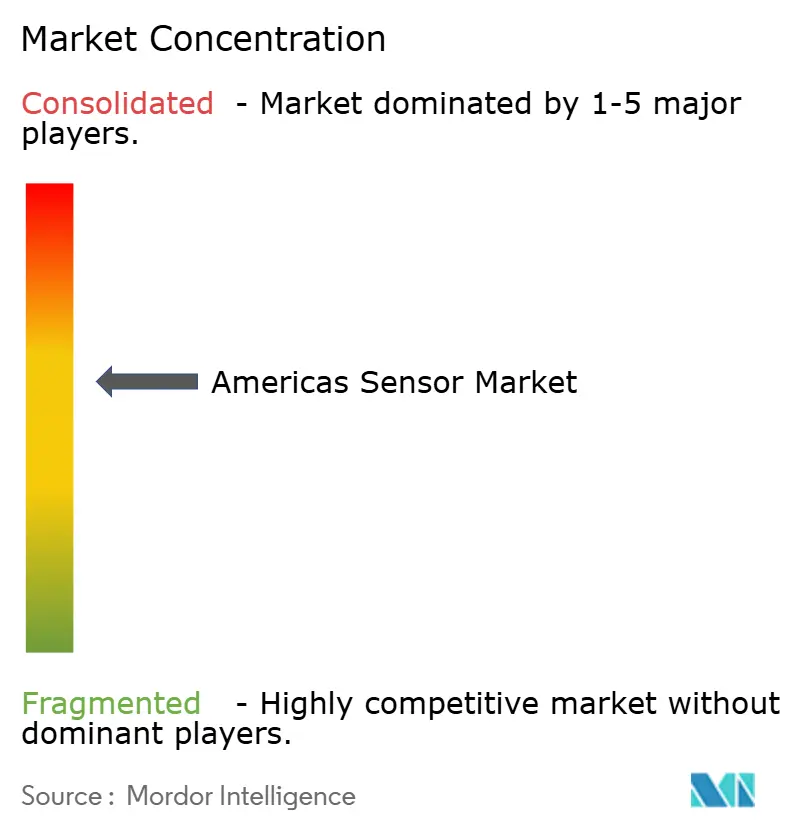
Recent Industry Developments
- July 2025: STMicroelectronics announces acquisition of NXP’s sensor business for USD 950 million, expanding MEMS and automotive portfolios.
- July 2025: Honeywell secures U.S. Department of Defense contracts for GPS-independent quantum navigation systems.
- June 2025: Boeing completes first quantum-navigation flight test using AOSense IMUs.
- March 2025: SICK and Endress+Hauser commence joint-venture operations focused on gas analysis and flow measurement.
Americas Sensor Market Report Scope
A sensor is a device that measures or detects a physical quantity and converts it into a signal, which can be read by an instrument or an observer.
The Americas' sensor market is segmented by type (temperature, pressure, level, flow, proximity, environmental, chemical, inertial, magnetic, and vibration), mode of operation (optical, electrical resistance, biosensor, piezoresistive, image, capacitive, piezoelectric, lidar, and radar), end-user industry (automotive, consumer electronics (smartphones, tablets, laptops, and computers, wearable devices, smart appliances or devices), energy, industrial, medical and wellness, construction, agriculture, and mining, aerospace, defense), and geography. The market sizes and forecasts are provided in terms of value (USD) for all the above segments.
| Temperature |
| Pressure |
| Level |
| Flow |
| Proximity |
| Environmental |
| Chemical |
| Inertial |
| Magnetic |
| Vibration |
| Other Parameters |
| Optical |
| Electrical Resistance |
| Biosensor |
| Piezoresistive |
| Image |
| Capacitive |
| Piezoelectric |
| LiDAR |
| Radar |
| Other Modes |
| MEMS Sensors |
| Non-MEMS Sensors |
| Automotive | |
| Consumer Electronics | Smartphones |
| Tablets, Laptops and Computers | |
| Wearable Devices | |
| Smart Appliances | |
| Other Consumer Electronics | |
| Energy and Utilities | |
| Industrial Automation | |
| Medical and Wellness | |
| Construction, Agriculture and Mining | |
| Aerospace | |
| Defense and Security |
| United States |
| Canada |
| Brazil |
| Mexico |
| Argentina |
| Chile |
| Rest of Americas |
| By Parameter Measured | Temperature | |
| Pressure | ||
| Level | ||
| Flow | ||
| Proximity | ||
| Environmental | ||
| Chemical | ||
| Inertial | ||
| Magnetic | ||
| Vibration | ||
| Other Parameters | ||
| By Mode of Operation | Optical | |
| Electrical Resistance | ||
| Biosensor | ||
| Piezoresistive | ||
| Image | ||
| Capacitive | ||
| Piezoelectric | ||
| LiDAR | ||
| Radar | ||
| Other Modes | ||
| By Sensor Technology | MEMS Sensors | |
| Non-MEMS Sensors | ||
| By End-user Industry | Automotive | |
| Consumer Electronics | Smartphones | |
| Tablets, Laptops and Computers | ||
| Wearable Devices | ||
| Smart Appliances | ||
| Other Consumer Electronics | ||
| Energy and Utilities | ||
| Industrial Automation | ||
| Medical and Wellness | ||
| Construction, Agriculture and Mining | ||
| Aerospace | ||
| Defense and Security | ||
| By Country | United States | |
| Canada | ||
| Brazil | ||
| Mexico | ||
| Argentina | ||
| Chile | ||
| Rest of Americas | ||
Key Questions Answered in the Report
What is the projected value of the Americas sensor market in 2030?
The market is expected to reach USD 55.78 billion by 2030.
Which parameter category grows the fastest through 2030?
Environmental sensors climb at an 8.2% CAGR, riding sustainability mandates.
Why is Mexico the fastest-growing geography?
Expanding EV and ICE vehicle production fuels sensor demand, pushing a 7.3% CAGR.
Which technology holds the largest Americas sensor market share today?
MEMS devices account for 59.7% of 2024 revenue.
How does quantum navigation affect future sensor demand?
Quantum IMUs promise GPS-free positioning, opening high-value defense and autonomous-vehicle opportunities.
Page last updated on:
